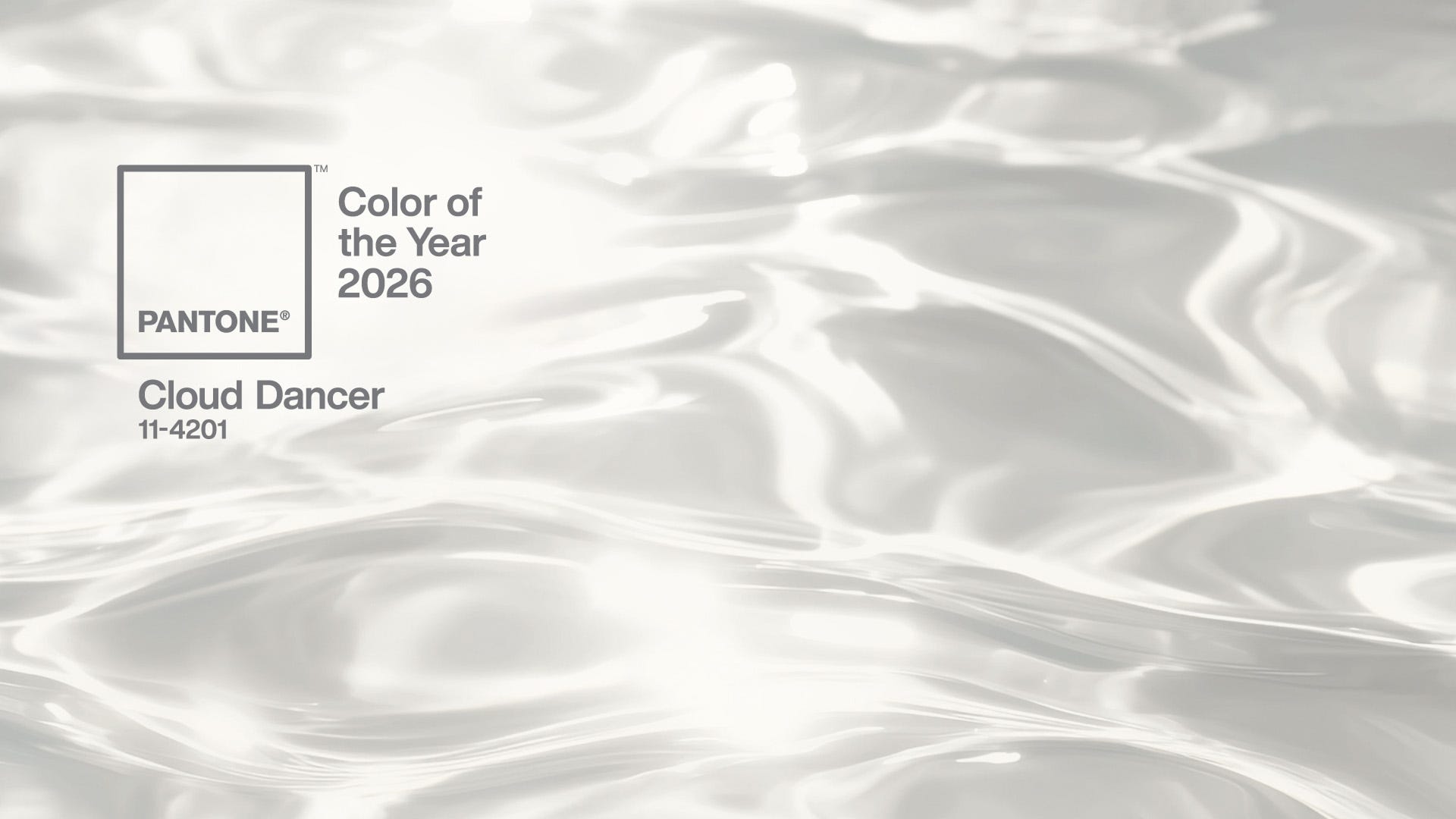.net Awards 2011: top 10 podcasts
This week we profile the top 10 podcasts for web designers and developers that you have nominated in the .net Awards 2011. Which one's your favourite show?
Whether video or audio, you have nominated 10 podcasts in the .net Awards 2011 that cover the subjects that web designers and developers are passionate about with energy, enthusiasm and authority. But only one of them can be our Podcast of the Year. Who is it going to be?
Our shortlist consists of some heavyweight long-running shows, but there's also a few new names. We asked the hosts of every podcast to tell us a little bit about their show, how they are recorded and what were their personal highlights of the year. We hope it will make it easier for you to decide on your personal favourite. Which one was the most informative and entertaining show of 2011?
The public voting stage is open until the end of this month. Then, during October, our judging panel will choose a winner from the public's top three in each category. The Awards will be presented at a VIP ceremony on 24 November.
So, here are the shows, in alphabetical order:
1. The Big Web Show

URL: 5by5.tv/bigwebshow
Hosted by: Jeffrey Zeldman and Dan Benjamin
Recorded in: New York City and Austin, Texas
Running since: April 29, 2010; 56 Episodes.
Format: Weekly, live, audio, sometimes video, about an hour
Subjects covered: The Big Web Show features special guests and topics like web publishing, art direction, content strategy, typography, web technology, and more. It's everything web that matters
.net: What have you been doing this year? What were the highlights of the screencast in 2011?
DB: Focusing on emerging talent, discussing the challenges facing aspiring designers, focusing on the business side of design.
A recent favourite episode is 5by5.tv/bigwebshow/55, where we talk to Marissa Christina to discuss her path as a web designer diagnosed with a debilitating vestibular disorder, and her blog Abledis.com, documenting living with a hidden disability.
.net: What kind of equipment do you use to record and edit the show?
DB: Too much to detail here, but how's this for a overly simplified answer: a dozen Macs, a pile of preamps, a 16-channel mixer, and about 1,000 feet of cable. I use a Heil PR-40 mic and Jeffrey uses a Rode Podcaster.
Daily design news, reviews, how-tos and more, as picked by the editors.
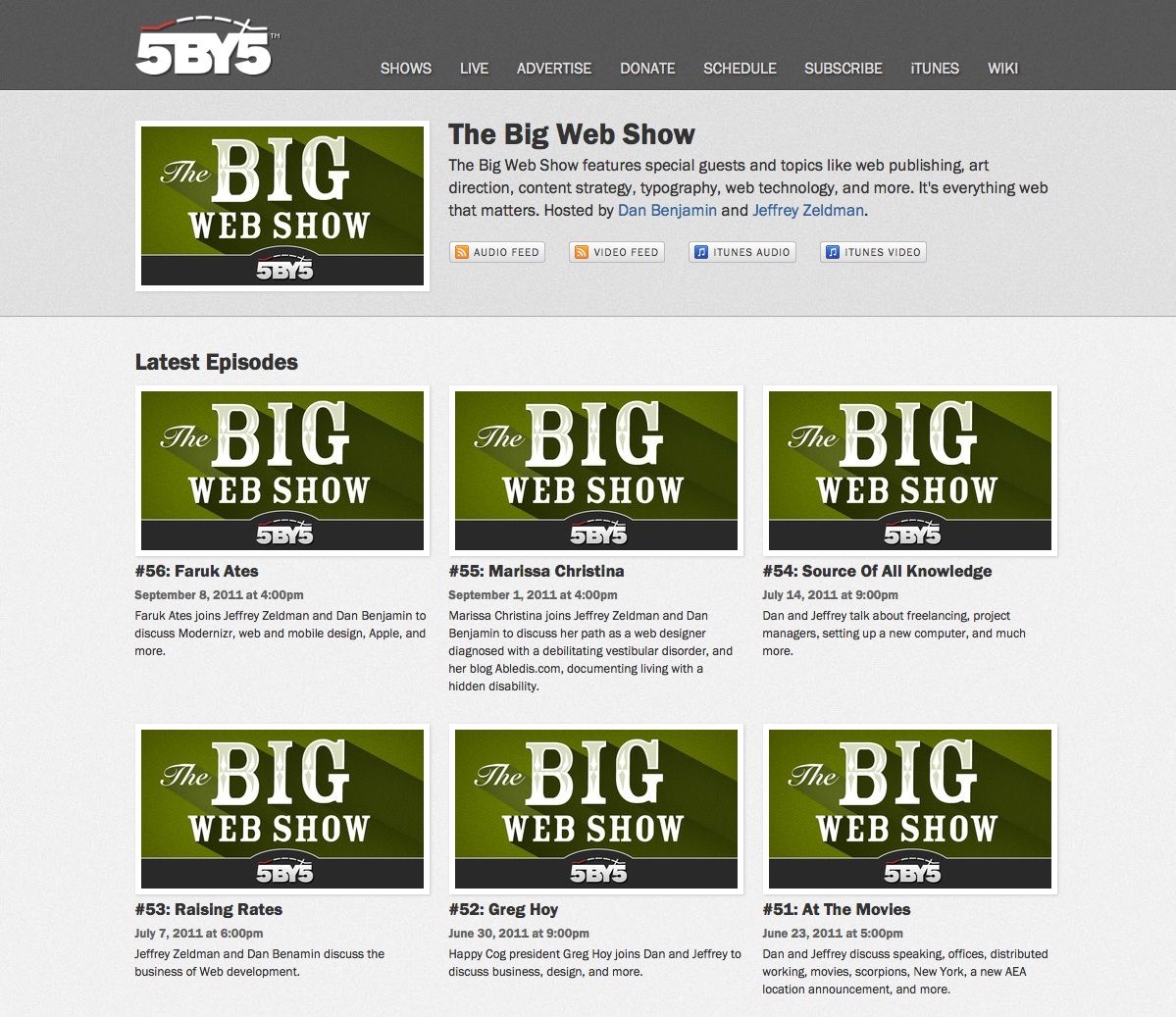
2. Boagworld
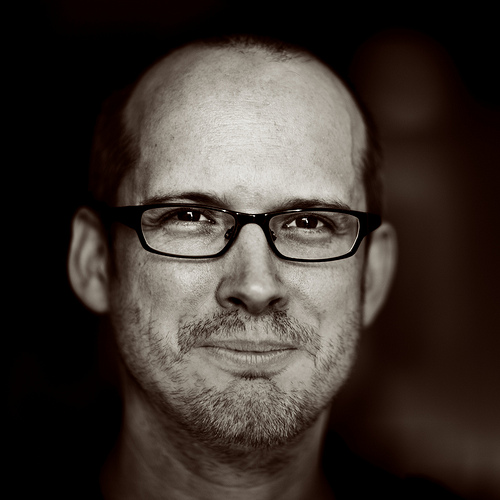
URL: boagworld.com/seasons/
Hosted by: Paul Boag and Marcus Lillington
Recorded in: Our beautiful barn in the heart of rural Hampshire
Running since: August 2005; 230 episodes
Format: Weekly, audio with occasional live video shows, Approximately 1hr
Subjects covered: Anything of interest to web designers, developers or website owners
.net: What have you been doing this year? What were the highlights of the screencast in 2011?
PB: This season of the show has focused on the redesign process of a website. Using boagworld.com as a case study we have covered everything from setting business objectives to working with WordPress.
.net: What kind of equipment do you use to record and edit the show?
PB: We record using a simple mixer desk, a very old Macbook Pro and a copy of Logic Pro. Not exactly high end audio gear!
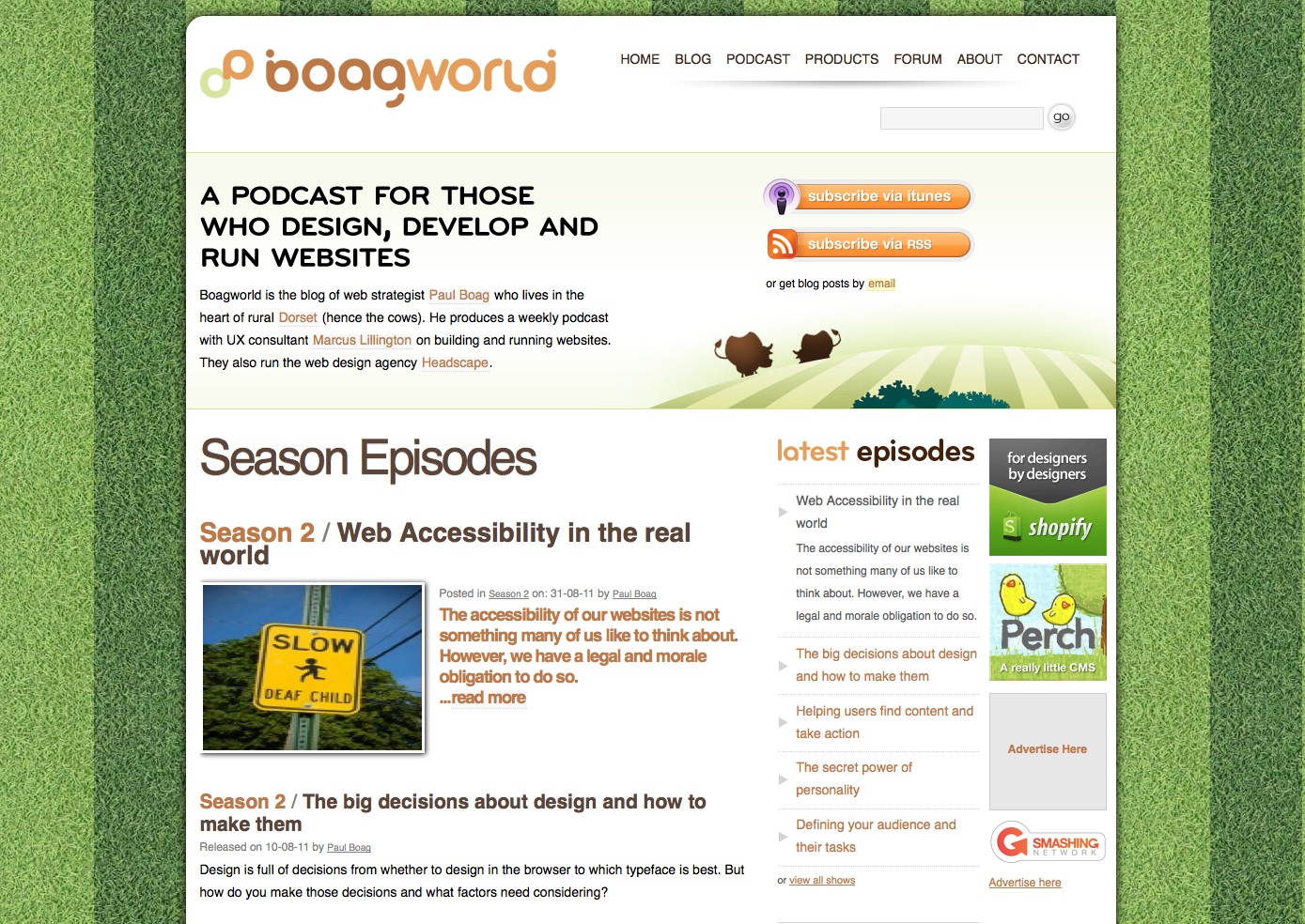
3. Creative Coding
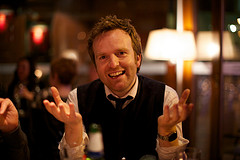
URL: creativecodingpodcast.com
Hosted by: Seb Lee-Delisle and Iain Lobb
Recorded in: Brighton, Truro and whichever international location Seb happens to be in that week
Running since: January 2011; 13 episodes
Format: Every two or three weeks, audio only, between 30 and 60 minutes
Subjects covered: Any creative coding platform! Processing, JavaScript, OpenFrameworks, iOS, Android, Flash, and more. We say that if you can make a ball bounce up and down in a technology, then we'll cover it
Size of audience: Around 10,000 downloads per episode
.net: What have you been doing this year? What were the highlights of the screencast in 2011?
SL: We've just started! We generally talk about developments in our field: new software, interesting projects. I think it works because we don't usually agree on very much. For me the highlight was going to the EyeoFestival in Minneapolis where I got to meet and interview many of the top digital artists in the world. It was also great that so many people recognised my voice from the show!
IL: We spend a lot of time arguing the relative merits of different platforms such as HTML5, Flash, Unity3D and iOS. I think there's a lot of corporate spin (as well as some fanboyism) around all these technologies, but we try to cut through all that, and be honest about what works in the real world. Hopefully we bring together coders from all backgrounds, because ultimately we're all just making things bounce around on the screen! The highlight for me is when I meet new people and they just start talking like we're already friends because they know me from the podcast!
.net: What kind of equipment do you use to record and edit the show?
SL: We use iPhone4 with FiRe recorder. We edit with Audacity and/or GarageBand.
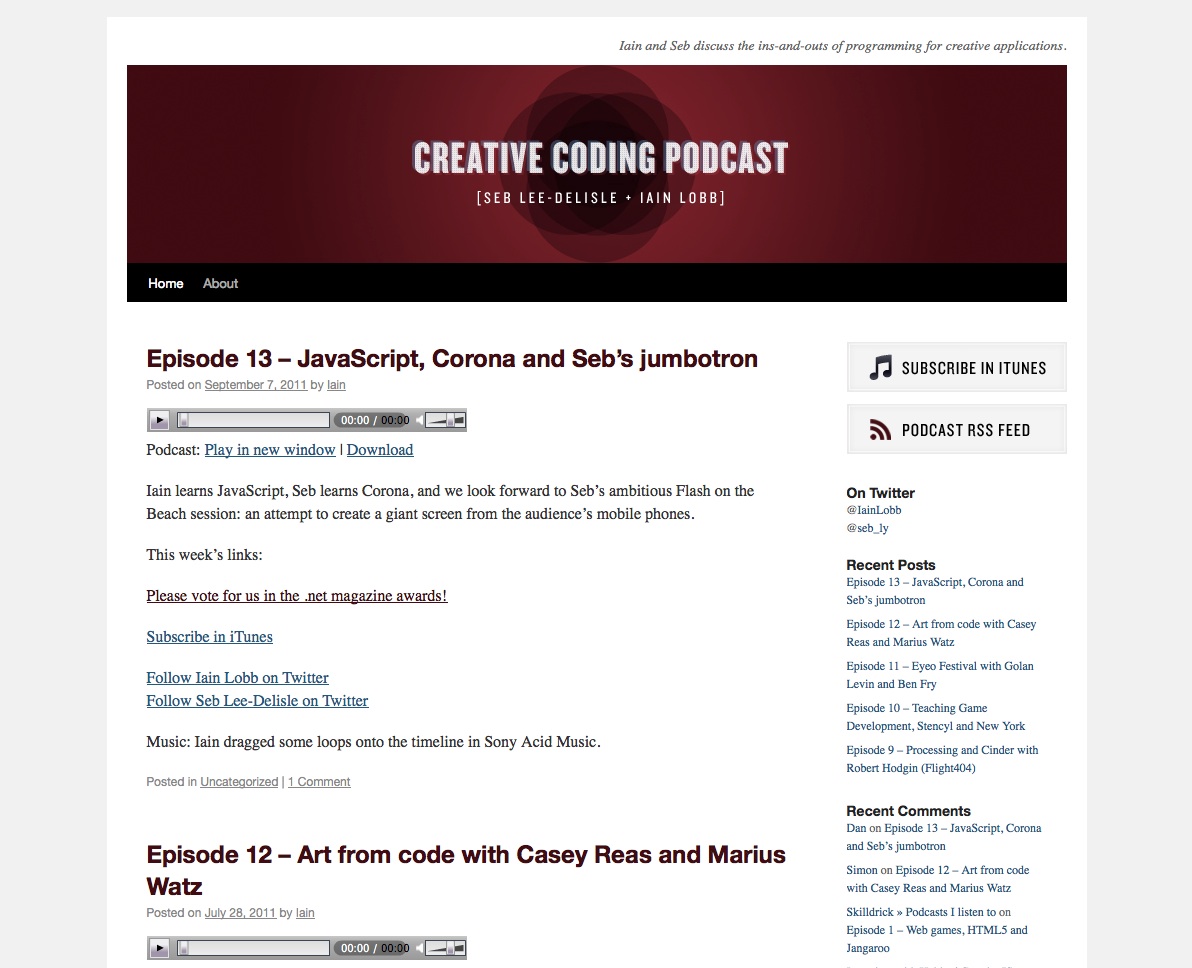
4. CSS-Tricks

URL: css-tricks.com/video-screencasts/
Hosted by: Chris Coyier
Recorded in: Chris' home office, Chicago
Running since: 2009; 102 episodes
Format: Randomish (previously weekly). Video screencast. Average of 30min in length
Subjects covered: Anything frontend web-related
Size of audience: Around 5,000 subscribers but the videos are downloaded closer to 40,000 times a month. In other words, lots more one-off viewers
.net: What have you been doing this year? What were the highlights of the screencast in 2011?
CC: Hitting the 100th episode was pretty cool. I didn't have any huge celebration or anything. But to honour it, I had a new intro animation done for it (and I even play the guitar for the music). I'm hoping to keep at it and do a bunch more screencasts. I have quite a list of ideas!
.net: What kind of equipment do you use to record and edit the show?
CC: I have a Rode Podcaster on a little mic stand/shock mount on my desk, and use ScreenFlow on my Mac.
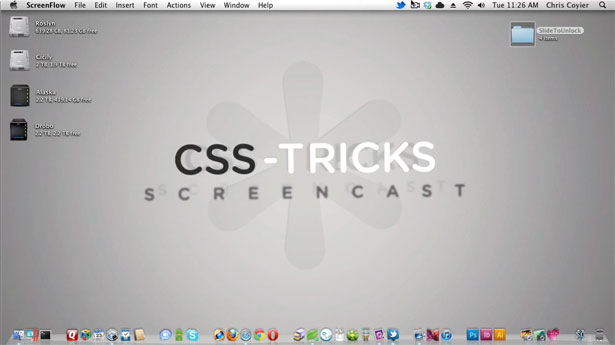
5. Nettuts+

URL: net.tutsplus.com/tag/videos/
Hosted by: Jeffrey Way
Recorded in: Chattanooga, TN
Running since: 2008
Format: Weekly, screencast, around 15-45 minutes each episode
Subjects covered: PHP, CSS, JavaScript, Ruby — practically everything
Size of audience: 90,000+ subscribers
.net: What have you been doing this year? What were the highlights of 2011?
JW: This year has been all about improving the quality of our screencasts, and branching out into new subjects (for us), such as Ruby. Recently, when Envato launched Webdesigntuts+, it became apparent that it's better for that site to focus more on HTML and CSS tutorials, while Nettuts+ digs a bit deeper into server-side architecture.
In terms of quality levels, we don't have an enormous budget for these episodes. In fact, they started out a few years ago with me blabbing into my computer's built-in microphone (a bit embarrassing really). Back then, I was still learning ASP.NET, and found a huge level of benefit from watching Joe Stagner's introductory screencasts. So, I thought to myself, "Hey, I can do that."
These days, all the videos are HD, the audio quality has been massively improved, and we record visual (my big face on the screen) introductions. At least in my opinion, the key to their popularity is that, rather than providing speedy high-level overviews of languages and subjects, we take a very hands-on approach, almost like we're sitting next to you on your computer. From my experiences, this is vital. We're here to teach, not show off how smart we are. Leave some bugs in the videos; watching someone debug is equally as educational as the actual subject matter. Don't paste 30 lines of code with 30 seconds of explanation. It may take longer to write and explain each line, but people will thank you for it. And besides, there's always a fast-forward button!
As a whole, my goal for Nettuts+ is to make it the one-stop stop for all things web development, particularly for those who are still in the "building up your skills" phase. Want to learn CSS3? Here's our Session. How about Sass? Here's another Session. What if you're brand new to web development? That's cool too. We have you covered. Ultimately, if it's a subject you want to learn, we should have a resource for you.
.net: What kind of equipment do you use to record and edit the show?
JW: - iMac set to a 1280x720 resolution
- Screenflow 3
- AT2020 USB Condenser Mic
- iMovie (occasionally)
That's honestly all you need to get started. While we could invest hours upon hours into post editing, animations and other additions, I tend to feel that it's better to release a dozen videos over the course of a couple months, as opposed to one or two.

6. This Developer's Life
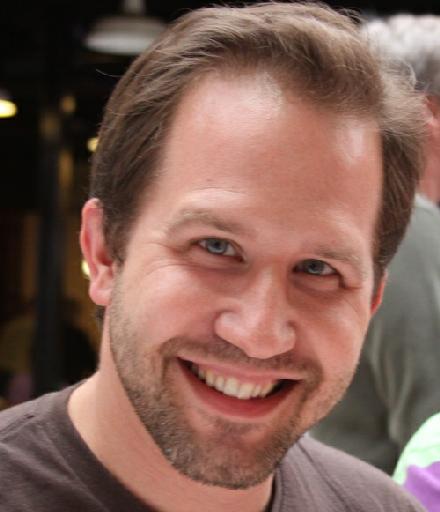
URL: thisdeveloperslife.com
Hosted by: Scott Hanselman and Rob Conery
Recorded in: Scott's home office, Oregon, and Rob's Office, Hanalei, Hawaii
Running since: 2010; 15 or so episodes
Format: Pretty much when we have a good story; usually every two to three weeks
Subjects covered: Stories about developers and their lives. Less technology, more about the person behind the keyboard and what makes them write the code/create the "thing" that they create
Size of audience: Pretty big at this point. We get close to 50K downloads per show (if I'm reading the stats right). Getting north of a million total downloads.
.net: What have you been doing this year? What were the highlights of 2011?
RC: For me, personally, it was the interview I just did with Bill Hill. An amazing guy that I've actually known for a while — but didn't know who he was! He lives on Kauai and we surf at the same spot together. He's one of those muscly, grizzled mountain man-looking types with a full grey beard, piercing blue eyes and a Scottish brogue that makes you smile. Scott and I were prepping for a show on "Fonts" and someone mentioned that I should talk to Bill: I come to find out he's out here and I already know him! A great story and a really interesting guy.
.net: What kind of equipment do you use to record and edit the show?
RC:I use a Rode Podcaster microphone with recording software on my Mac. It used to be Garage Band but I've moved to using Final Cut Pro X. I have a Tascam mobile rig (that I need to upgrade).
SH: I use a Shure Mic and an M-Audio portable rig with a vocal booth from Real Traps. Skype and CallBurner for remote stuff.
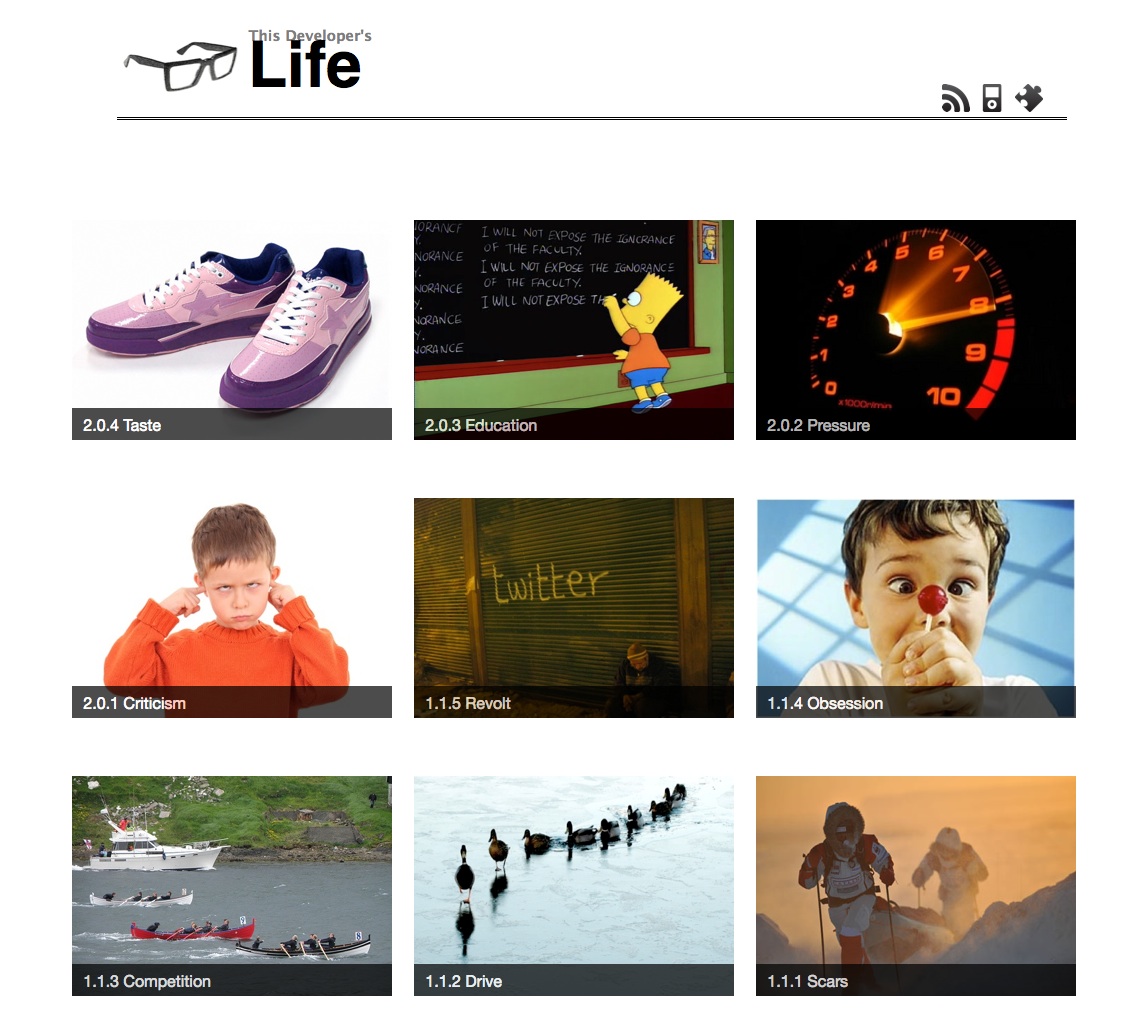
7. The SitePoint Podcast
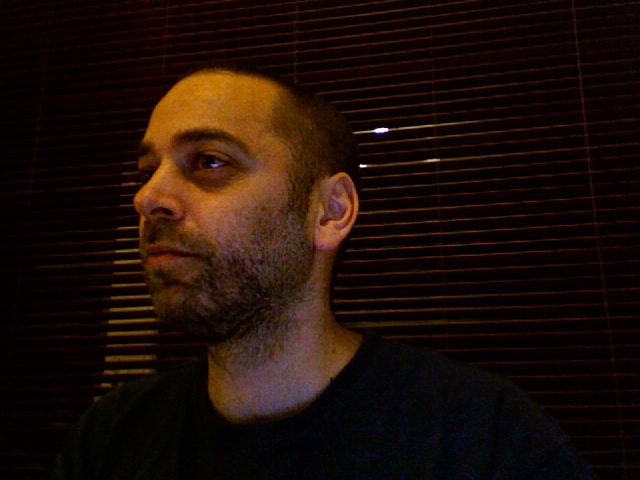
URL: www.sitepoint.com/category/podcast/
Hosted by: Louis Simoneou is the main host. Patrick O'Keefe, Brad Williams and Stephan Seagraves the co-hosts for the news shows
Recorded in: Louis records at SitePont headquarters, recording himself and the interviewees via Skype. Occasionally our interviewees will record themselves locally. On the news shows, each host records themselves locally, and in all cases I then bring the files together in the edit
Running since: Episode 1 was released 10 November 2008, was initially fortnightly, then has moved to every week, and we are now on show 130
Format: Now a weekly audio podcast, with shows ranging from 30mins to one hour in length
Subjects covered: We cover all things web related, not just design related, but news of large web companies (like Google buying Motorola Mobility) and things relating to the hardware people use on the web. If it has an effect on the web 'landscape', we're interested!
.net: What have you been doing this year? What were the highlights of 2011?
Karn Broad, producer of the SitePont podcast: I am working on a few websites to be released in three months time or so for long standing clients (clients of WebKarnage.net), and I've been working myself not just with SitePoint, but also with Realmac Software, the makers of RapidWeaver, LittleSnapper and Courier for the Mac. I also get to do some audio sessions still as an engineer for Rainbow Productions in Haywards Heath.
The big thing really has been our coverage of the Responsive Design approach, with interviews of people like Jeremy Keith from Clearleft and Chris Coyier of CSS-Tricks.com as we all feel this exciting new era of web design coming to real fruition, notably with the release of the Boston Globe website which we covered in show number 130. There was also the nearly 'gotcha' where we pulled the coverage of a hoax story just in time!
.net: What kind of equipment do you use to record and edit the show?
KB: Each regular host records locally to them, with varying equipment choices. All communication during recording is done via Skype. I then take the recorded files and clean them up in Soundtrack Pro to reduce noise and other unwanted sounds, before editing and compressing the audio in Logic Pro.
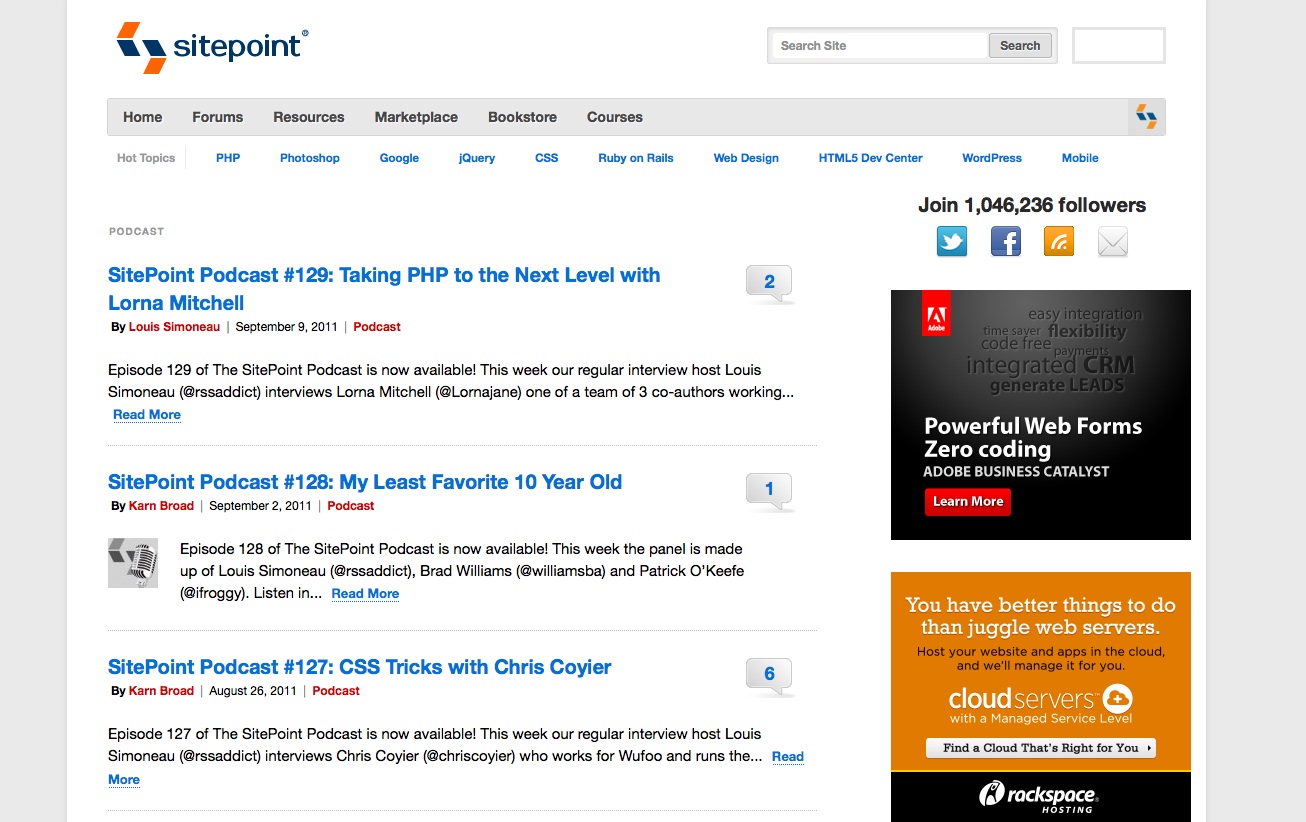
8. The ExpressionEngine Podcast

URL: ee-podcast.com
Hosted by: Lea Alcantara and Emily Lewis
Recorded in: Lea and Emily's offices in Edmonton, Alberta, Canada and Albuquerque, New Mexico, USA
Running since: September 2009; 51 episodes
Format: Bi-weekly, audio only, previously live with video, approximately 30-40 minutes
Subjects covered: ExpressionEngine, web design, web development, professional practices, personal and professional community updates and news, technology, best practices
Size of audience: Around 600 subscribers, 2,700 hits on the site/month, approx 3570 downloads since Aug 2011
.net: What have you been doing this year? What were the highlights of 2011?
LA: 2011 brought a change in hosts, as Ryan Irelan left to pursue other opportunities and Emily Lewis came on board to co-host with Lea. We also moved from the 5By5 network to our own redesigned, custom-coded site (ee-podcast.com) hosted by EngineHosting. Speaking of the new site, we not only have archives of all 5By5 recordings, we are adding new features regularly, including transcripts of our podcasts.
As far as highlights go, we now have a regular (bi-weekly) schedule with topics planned in advance, so our listeners can plan too. And our topics are getting a bit broader than we have had before, such as our recent episode (#51) where we talked to designers and devs who travel while they work. It was a really inspiring episode, and we hope to do more to focus on the parts of our non-working lives that impact our work.
.net: What kind of equipment do you use to record and edit the show?
LA: We both use iMacs, Call Recorder for Skype to record, USB mics — Emily has a Blue Snowflake and I use a Rode Podcaster — and we edit using GarageBand.
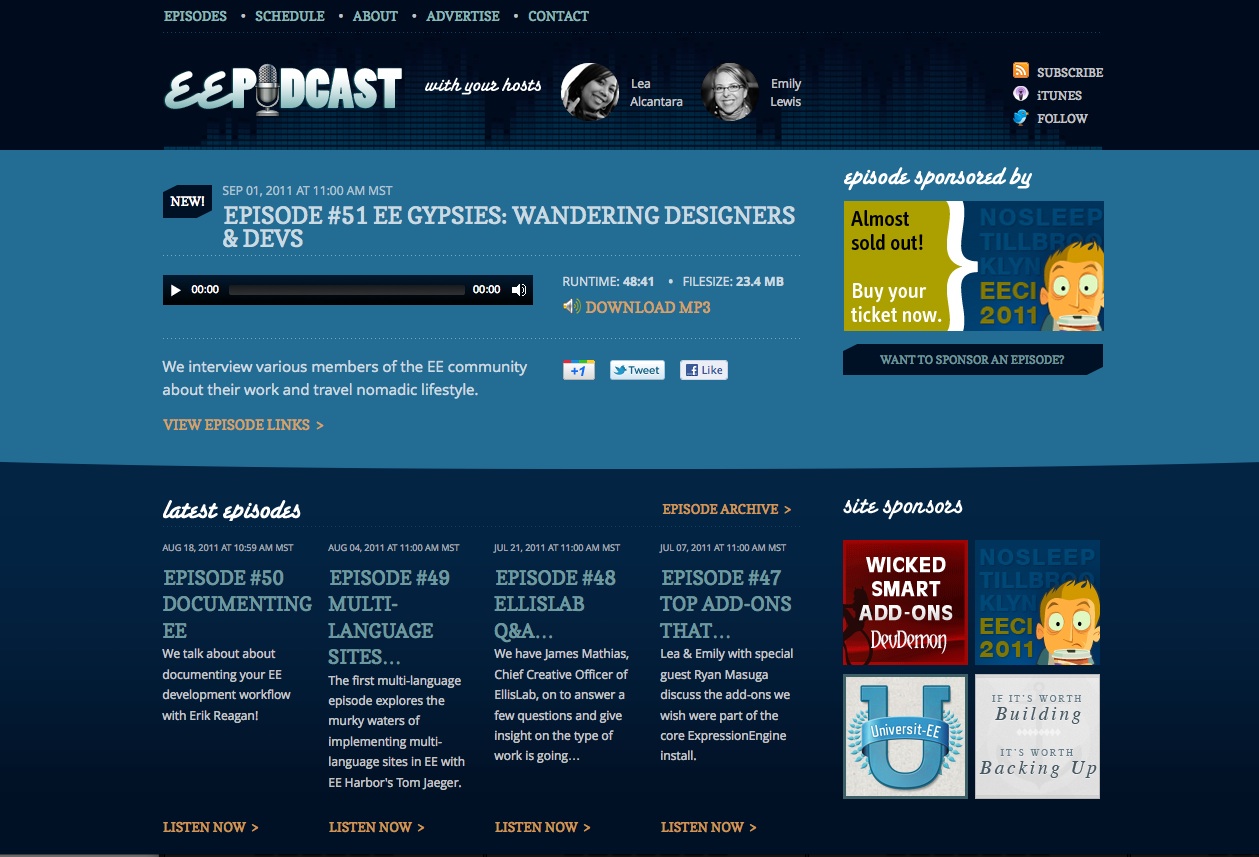
9. Think Vitamin
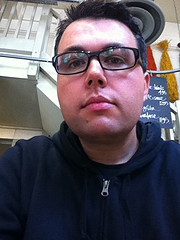
URL: thinkvitamin.com/podcast/
Hosted by: Keir Whitaker with Mike Kus and Ryan Carson (occasionally special guests are brought in either via Skype or most commonly in person)
Recorded in: Carsonified Office, Bath, UK
Running since: January 2010; currently up to Episode #33 and it’s released every two weeks
Format: Audio, between 30 and 45 minutes per episode
Subjects covered: Each episode starts with a chat about some of the new and interesting sites and developments we’ve come across and is usually followed by a more in-depth discussion about a particular topic. Recent examples include pricing, Sass, workflow and executing ideas
Size of audience: Average 7,000 downloads per episode. Most popular episode is around 12,000
.net: What have you been doing this year? What were the highlights of 2011?
KW: 2011 was a year of change. What started out as a company podcast rapidly changed into much more of an independent show as Keir and Mike both left Carsonified to go freelance. This opened up the topics of conversation a lot more as they were both getting back to the coalface of dealing with clients and project work, as well as embracing new technologies such as Sass, on a daily basis. Hopefully this offers more value to listeners as there are more perspectives being talked about.
In terms of highlights there have been some really good discussions around issues affecting freelancers and small businesses including setting your rate, accounting, workflow and approaches to making money from your side projects.
.net: What kind of equipment do you use to record and edit the show?
KW: We record using three condenser microphones, which plug into a Behringer XENYX 1204FX mixing desk. We also have headphone monitoring, which really helps with sound levels. The output is fed into a Mac Book Pro using a USB connection and recording in stereo into Audacity. We then clean up the background noise, add in the intro sting and reduce to mono. This mix is then feed into the Levelator and converted to MP3 to upload to the web.
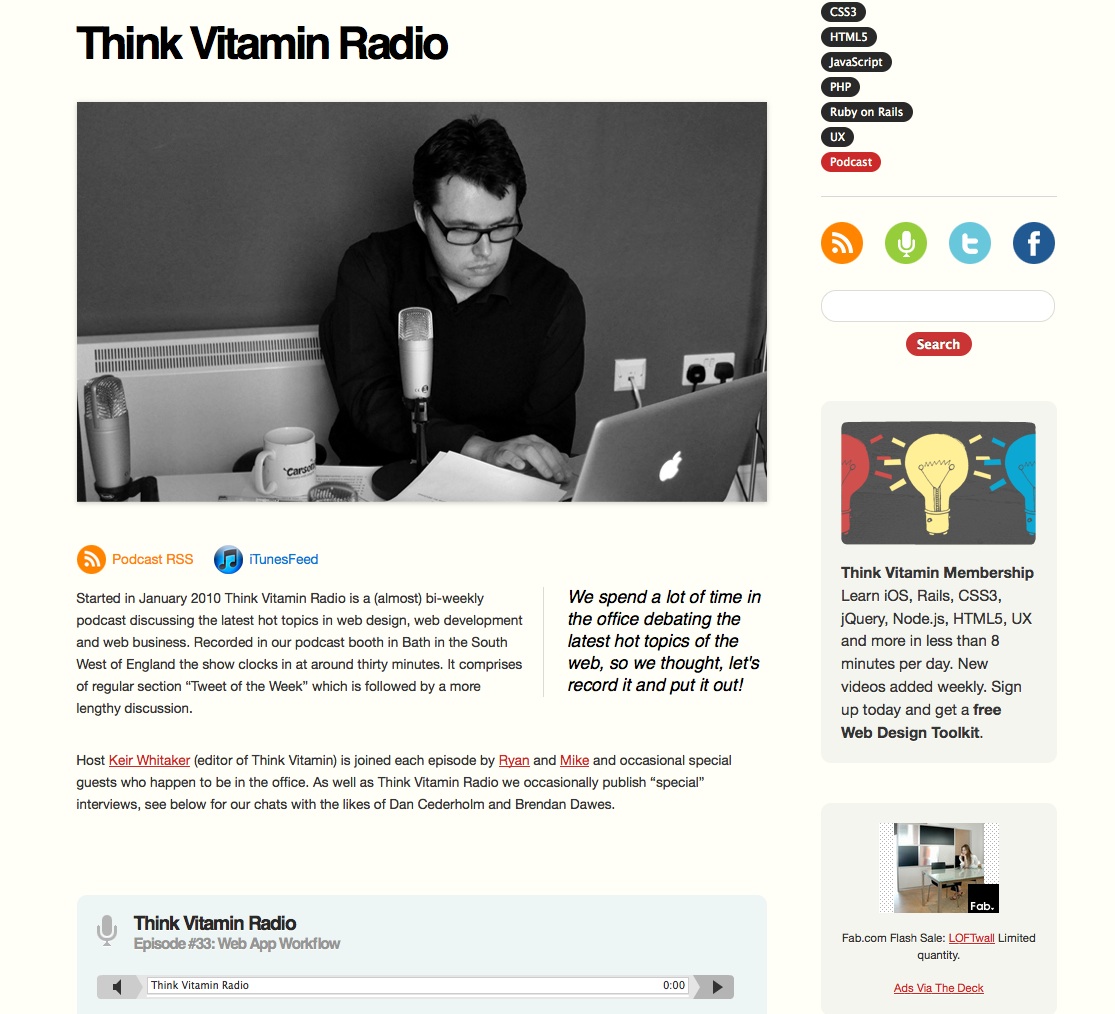
10. Unmatched Style
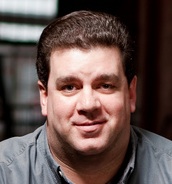
URL: unmatchedstyle.com/podcast/
Hosted by: Gene Crawford and Jay Barry
Recorded in: The UnmatchedStyle office, Columbia, South Carolina
Running since: 2009; 67 Episodes
Format: Weekly(ish), pre-recorded, Vvdeo, 10 minutes each
Subject covered: Web design, frontend, UX, usability, design
Size of audience: We have around 150K uniques a month, but 1,000 or so views each episode per month
.net: What have you been doing this year? What were the highlights of 2011?
GC: We've been working hard on a redesign and engaging in the web design community. We had a very successful third year conference with convergese.com in June and we just launched unmatchedstyle.com/cssoff/, which will be a ton of fun. We've been focusing on doing as many interviews with our favourite people on the internet the past year and look to continue that most heartily as we push on.
.net: What kind of equipment do you use to record and edit the show?
GC: We use two Canon HV20/HV40 Cameras. JuicedLink CX231 Mixer for Audio. Wired Sony and Audio Technica Lavalier Mics. JTL 3 Light kit. Adobe Premiere for editing.
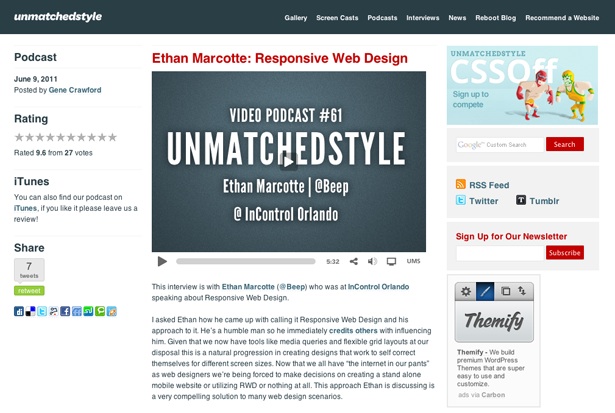
So, what's YOUR favourite web design/development podcast? Make up your mind and head to www.thenetawards.com to cast your vote now!
And if your favourite show has not made the shortlist, please let us know in the comments!

The Creative Bloq team is made up of a group of art and design enthusiasts, and has changed and evolved since Creative Bloq began back in 2012. The current website team consists of eight full-time members of staff: Editor Georgia Coggan, Deputy Editor Rosie Hilder, Ecommerce Editor Beren Neale, Senior News Editor Daniel Piper, Editor, Digital Art and 3D Ian Dean, Tech Reviews Editor Erlingur Einarsson, Ecommerce Writer Beth Nicholls and Staff Writer Natalie Fear, as well as a roster of freelancers from around the world. The ImagineFX magazine team also pitch in, ensuring that content from leading digital art publication ImagineFX is represented on Creative Bloq.
